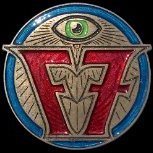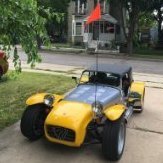-
Posts
144 -
Joined
-
Last visited
-
anduril3019 started following Cycle wings? , PSA: Great deal on 7" H4 headlights (~$20 for a pair) - Not me selling , White Lotus 7… and 7 others
-
Starting at @ 0:55 is about how my wife describes my project to her friends. (she's a good sport) Now jump to 2:17 and I just remind her, "But look how much fun we'll have...!"
-
http://www.blueskyracing.com/index.htm
-

Are there many Lotus produced Seven owners on this forum?
anduril3019 replied to EdWills's topic in General Sevens Discussion
With all the unknowns on tariffs, as well as NOS items getting harder to find, it's a good idea to capture and reuse as much of your original smoke as possible. -
Extra points for the Campy logo.
-

Are there many Lotus produced Seven owners on this forum?
anduril3019 replied to EdWills's topic in General Sevens Discussion
Also not many home-built or "Locosts" on this site. Locostusa.com has been the home for that niche, but there are often tech issues with the forum, partially due to waning interest and/or participation. I'm a locost builder, leaning toward original Lotus style, and glean something of interest here almost daily. -
FWIW I inquired about a set of wheels I'm thinking about from retroford.co.uk and got this reply: We frequently send parts to the US and have had no issues with shipping the goods. We do not charge any taxes on the goods when exporting; you would need to organise the import taxes/duties to be paid with the shipping provider (typically UPS or FedEx). Additionally, all goods imported in to the US from the UK will now be subjected to a 10% tariff on the value of the goods.
-
I came across this article on lotuselans.net about repairing capillary tube gauges and it seemed like fun to give it a shot. I just happened to have a water temp gauge I bought cheap on ebay thinking I might use the face and needle on another gauge, so it seemed like a good candidate for repair with nothing to lose. The article on lotuselans.net seems to be based on some other articles with good details: https://forums.lotuselan.net/t/smiths-dual-oil-water-temp-gauge-repair/24987 https://mgaguru.com/mgtech/dash/dt102b.htm#:~:text=Measured diameter of tubing on,is used for electrical wiring). https://www.ply33.com/Repair/tempgauge#:~:text=Do not use a torch,fit for the old capillary. I won't rehash the links above, for more "how-to" detail, read those first, but here are a few things I ran into. The first thing of note is the article suggests finding a cheap mechanical gauge at Advance Auto Parts for $15. That was in 2018. I didn't look too hard, but the best I could do was about $30 for a Dorman gauge on Amazon. One thing to watch for, some of the gauges advertised as analog, or mechanical, use an electronic sending unit and wire that is covered with a metal coil that looks like a capillary tube, don't get one of those. If there is any tube left on the gauge, I think the best way to attach the new tube is to sleeve and solder as mentioned in the article. Mine had a very short stub left so I first tried to de-solder and remove it, but felt like it was getting too hot without releasing the solder. So, I filed the stub flat and drilled it out. The new tube measured .050" diameter, so I drilled the gauge back out with a #55 (.052") drill. That proved to be too tight, and the next best thing I had on hand was a 1/16" drill, so, a little loose, but in the end it worked. I drilled it about 3/16" deep and made sure the ID was clear using a sewing needle. The next step was getting cold water to keep the bulb contents (ether?) in a liquid state. Out of curiosity, I wanted to see what temperatue difference I could get between plain ice water, and salted ice water. Plain ice water got down to about 33° by my kitchen thermometer. I took that chilled water, strained out the ice, and was able to dissolve about 1 1/2 tablespoons of salt in it. After adding fresh ice, the temp dropped down to about 25°. The next step was chilling the bulb and cutting the tube. I was able to work the coil shield back a couple of inches and expose the capillary tube. I cut it with a cutoff wheel so as not to crush it, then dressed the end and cleaned it out with the sewing needle. I tinned a section of the tube before cutting thinking it might ensure I didn't clog the tube with solder. After cutting the tube, I was trying to push the coil back a little further and got a little spurt of liquid out the end of the tube, I must have compressed something. So care is warranted, and safety glasses! Now is when I found my drilled hole to be too small. The tinned end fit fine in the 1/16" hole, not too loose. Since it was hard to de-solder in the beginning, I was worried about getting enough heat into it with a soldering iron and no flame, but it actually soldered pretty quick and seemed like a well flowed bond. Now is when I wished I'd thought of some kind of strain relief. I'll add something after now. After what seemed like a successful connection, on to testing! As my water temp rose to around 100° there was no needle movement, the gauge starting at 90°. So, I figured, oh well, nice try, and was deciding whether I would try again or not. But as the water temp rose, the gauge started to move! At boiling temp, it's within a few degrees of my thermometer. Probably not as accurate or responsive as a modern gauge, but good enough that I can call it a working gauge! I compared it to a working dual gauage I have, and temp read about the same. All-in-all, I'm calling it a success!
-
- 4
-

-

-
Looking for a rabbit hole to go down? Try The Internet Movie Car Database Lotus 7 (Mark VII) page here: https://www.imcdb.org/vehicles.php?make=Lotus&model=Mark+VII&modelMatch=2&modelInclChassis=on
- 1 reply
-
- 3
-

-
Here are mine. Looking at them now, I'm not sure why I didn't use stainless steel. But as far as the work from SendCutSend is concerned, I'm completely satisfied. In terms of cost, it's always a personal calculation: How much time will it take me to make them myself with limited tools, will they look as nice and function as well, etc.. There's also a pretty significant per item cost savings for higher quantities.
-
Nice! I made almost the exact same parts through them, but all 1/16" thick, I like the thickness variety of yours.
-
These are 10" wide x 40" long x 26" diameter. They are in good shape, what looks like damaged fiberglass is just stretch wrap that has decomposed. They came off of a Caterham with 13" wheels, mounts are for Caterham/Triumph uprights.
-
I may have a set. I can send you dimensions tonight. Can you explain what you mean by "not long enough"? Are you measuring diameter?





